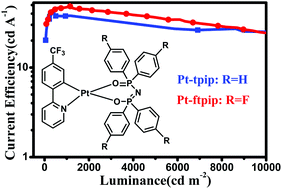Syntheses, photoluminescence and electroluminescence of two novel platinum(ii) complexes†
Abstract
Two new platinum(II) cyclometalated complexes with 2-(4-trifluoromethyl)phenylpyridine (4-tfmppy) as the main ligand and tetraphenylimidodiphosphinate (tpip) (Pt-tpip) and tetra(4-fluorophenyl)imidodiphosphinate (ftpip) (Pt-ftpip) as ancillary ligands were developed. Both complexes were green phosphors with photoluminescence quantum efficiency yields of 71.5% and 79.2% in CH2Cl2 solution at room temperature, respectively. The organic light-emitting diodes with a double emissive layers structure of ITO/TAPC (1,1-bis(4-(di-p-tolylamino)phenyl)cyclohexane), 40 nm/Pt-tpip or Pt-ftpip: TcTa (4,4′,4′′-tri(9-carbazoyl)-triphenylamine) (5 wt%, 10 nm)/Pt-tpip or Pt-ftpip: 2,6DCzPPy (2,6-bis(3-(carbazol-9-yl)phenyl)pyridine) (5 wt%, 10 nm)/TmPyPB (1,3,5-tri(m-pyrid-3-yl-phenyl)benzene, 40 nm)/LiF (1 nm)/Al (100 nm) showed good performances. In particular, the device based on the Pt-ftpip complex with a 5 wt% doped concentration showed superior performance with a low drive voltage of 3.3 V, a maximum current efficiency of 48.3 cd A−1, a maximum external quantum efficiency of 14.0%, and a maximum power efficiency of 35.7 lm W−1, respectively. Even at a brightness of 1000 cd m−2, a current efficiency of 47.0 cd A−1 could still be obtained, suggesting that the ancillary ligands (tpip and ftpip) can be employed well in Pt(II) complexes, which could find potential applications in OLEDs.


 Please wait while we load your content...
Please wait while we load your content...